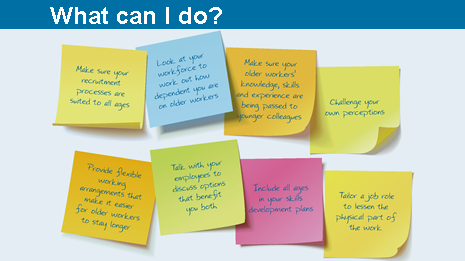What can I do?
An ageing population and workforce means that making work more inclusive for older workers will be increasingly important for employees, employers and the economy.
To prepare for these demographic changes , large and small employers alike can take steps to Train, Retain and Recruit older workers.
Age profiling allows you to take a clearer look at the age of your workforce now and in the future.
It can help you to predict trends and identify areas where you have more older workers and may need to have conversations about retirement and flexible work options.
Research carried out by the UK Working Longer Group showed managers are often reluctant to discuss retirement with staff, but open and constructive discussions are vital to help workforce planning in the future.
Larger organisations may need to develop a dedicated strategy for the retention of older workers. For SMEs, it may be as simple as just considering one or two older individuals whose contribution is significant to their business.
Early consideration and discussion of work and retirement options can be helpful to staff and employers and age profiling should be undertaken regularly to help you plan ahead.
What can I do?
-
Consider the age profile of your workforce
-
Check if some of your older workers have knowledge, experience or expertise that don't exist anywhere else in the organisation
-
Are there steps you could take to keep your older employees' skills in the business or give you time to succession plan such as flexible working arrangements or phased retirement?
-
Can an older worker contribute more or better in another area of the business where their skills would be an asset? Would training enable that?
-
Are line managers equipped to deal with age related issues?
-
Is your workplace ageist? Explore people's attitudes to older workers
-
Consider the concerns or barriers your older workers may be worried about. Talking to them about their working lives can unearth issues that may be easily addressed.
There are various resources and tools available to help you which are provided by external organisations. Some examples are below:
Business in the Community – The Mid-Life MOT: Helping employees navigate mid-life
Developing the skills of your staff can lead to increased productivity and efficiency, as well as improving morale and loyalty. This applies to older workers as much as younger ones, yet training often stops by the age of 50.
With a shortage of young people coming onto the recruitment market, it is vital for businesses to continue upskilling older workers whom they cannot afford to lose.
What can I do?
-
Ensure your skills development plans cover all ages of your workforce
-
Encourage a culture of continuous learning and development for everyone
-
Provide appropriate training for line managers on age related issues so they can confidently deal with ageing employees.
We have no automatic retirement age anymore and yet many people leave work before they want to – or the business wants them to - taking their skills and experience with them.
This may be because of ill health, caring responsibilities, lack of development or variety, or because they want a better work-life balance.
What can I do?
- Find out why your staff may leave prematurely, and take steps to retain their expertise for longer
- Ensure line managers are trained to deal with mid-life career development and age related issues
- Hold discussions with employees to discuss work and retirement and explore whether a different approach could help them work longer
- Vary roles through training - new skills don’t just increase productivity and loyalty, the variety they bring can keep people working longer
- Introduce mentoring (both formal and informal) – mentoring other employees adds interest and sense of self-worth as well as ensuring knowledge and expertise are shared among your workforce
- Encourage older workers to use new technology confidently by providing skills training
- Improve the physical working environment, perhaps limiting physical work, varying tasks and making small workplace adjustments
- Offer flexible working arrangements for staff at all stages of life, on an ongoing basis or as part of a phased retirement - for example, part-time hours; jobshare; flexi-time; a compressed working week; joining a retirement pool for use in busier times; additional unpaid leave or a career break
- Promote a healthy lifestyle for all employees, showing your care about their wellbeing.
Some employers also offer additional support, such as wellbeing programmes and financial planning advice.
But whatever employers offer, they all report that their business benefits from retaining an older workforce.
An ageing recruitment market can bring experience, talent and knowledge – and businesses need to make sure they appeal rather than alienate older workers.
Age discrimination is, of course, illegal except in a handful of exceptional cases. Most of us have no intention of discriminating, but it’s worth revisiting your standard recruitment practices just in case.
What can I do?
- Ensure language is age-neutral
- Ensure adverts are placed where older as well as younger recruits will see them
-
Promote your business as an age-positive employer. For example by stating “we welcome applications from people of all ages”
-
Ensure candidates are evaluated on their skills and experience, regardless of age
- Highlight all the elements of the post which older people may find appealing. For example flexible working arrangements.

